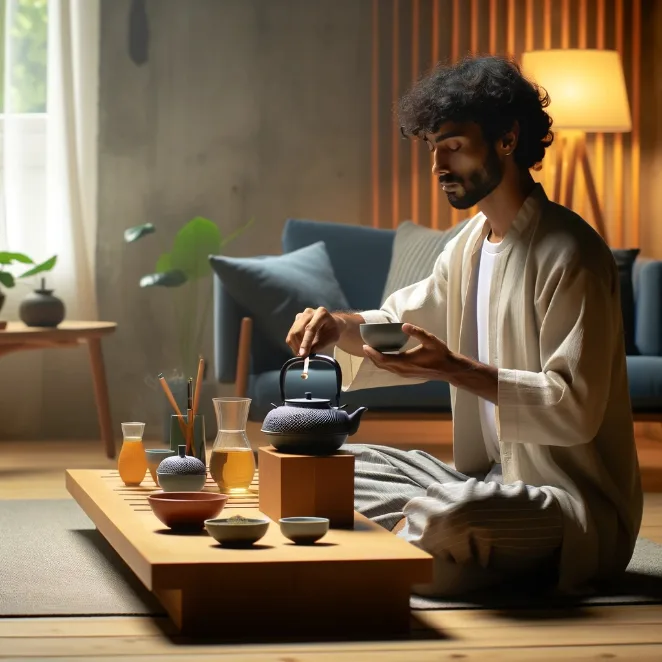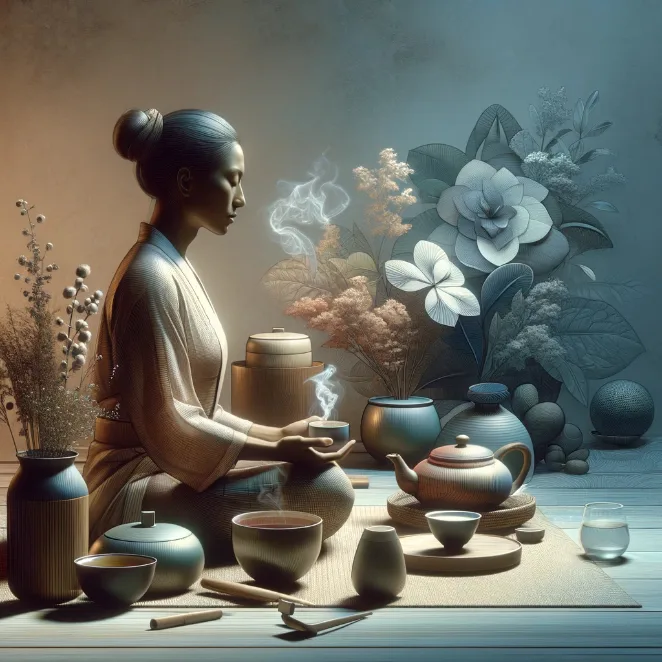
The Ritual of Tea Ceremonies and Mindfulness
Tea ceremonies, steeped in tradition across various cultures, are not just about the act of drinking tea but are a form of art that embodies mindfulness and presence. These ceremonies, ranging from the Japanese Chanoyu to the Chinese Gongfu tea ceremony, offer a peaceful retreat from the hectic pace of modern life. This article delves into the serene world of tea ceremonies, exploring how this ancient ritual provides a unique opportunity for mindfulness practice. By participating in or observing these ceremonies, one can experience a profound sense of calm and focus, transforming the simple act of drinking tea into a meditative journey.
article by Hina Kurosawa
The Essence of Tea Ceremonies
At its core, the tea ceremony is about more than just brewing and serving tea; it is a ritualized form of making and consuming tea, with a deep focus on the present moment. "Each step of the tea ceremony, from selecting the leaves to pouring the tea, is performed with deliberate care and attention," explains tea master Li Wei. This attention to detail turns the preparation and drinking of tea into an act of mindfulness. The slow, deliberate movements encourage participants to focus on the here and now, pushing aside distractions and worries. In cultures where tea ceremonies are practiced, such as in Japan and China, they are often considered a spiritual exercise as much as a social or gastronomic one. The tea ceremony creates a space for tranquility and contemplation, offering a momentary escape from the noise of everyday life.

Mindfulness in Every Sip
The ritual of a tea ceremony encourages mindfulness in every aspect. Participants are often advised to observe the color, aroma, and flavor of the tea, fully immersing themselves in the experience. "Mindfulness in a tea ceremony comes from appreciating the tea's subtleties – its aroma, taste, and even the warmth of the cup in your hands," says Li Wei. This mindful appreciation extends to the environment and the tools used, each element carefully chosen and regarded. The act of drinking tea becomes a meditative practice, with each sip drawing the participant deeper into a state of calm and focus. In this way, the tea ceremony transcends its cultural origins, becoming a universal practice of mindfulness accessible to anyone regardless of their background.
The Cultural Significance of Tea Ceremonies
Different cultures have imbued their tea ceremonies with unique meanings and rituals, yet all share an underlying emphasis on mindfulness and harmony. In Japan, the Chanoyu or Japanese tea ceremony is a choreographed ritual influenced by Zen Buddhism, reflecting principles of harmony, respect, purity, and tranquility. The Chinese Gongfu tea ceremony, on the other hand, focuses on the art of tea preparation, allowing for a deep appreciation of the tea's flavors and aromas. These ceremonies are not just social events but are seen as avenues to foster inner peace, build community, and even as a form of artistic expression. Despite their regional differences, these ceremonies universally promote a mindful approach to life, celebrating the beauty of simple, everyday moments.
Uniting Tea, Mindfulness, and Meditation
The practice of tea ceremonies seamlessly integrates with mindfulness and meditation, creating a holistic experience that nurtures both mind and body. As participants engage in the ritual of preparing and savoring tea, they naturally enter a meditative state, similar to that achieved in traditional meditation practices. "The tea ceremony is a form of moving meditation, where each action is an opportunity for mindfulness," reflects Li Wei. The quiet focus and repetitive motions of the ceremony encourage a state of flow, where the mind is fully immersed in the present moment, free from distractions. This synergy of tea and mindfulness amplifies the meditative benefits, offering a unique pathway to tranquility and heightened awareness. The ritual becomes a bridge between the busy external world and the serene inner landscape, providing practitioners with a tool to access deeper levels of consciousness. Embracing the tea ceremony as a meditative practice allows for a profound exploration of mindfulness, deepening the connection with oneself and the world around.
Modern Adaptations: Tea Ceremonies in Contemporary Life
In contemporary times, the practice of tea ceremonies has evolved, becoming more accessible and adaptable to modern lifestyles. While traditional elements are still revered, there is a growing trend of incorporating tea ceremonies into daily routines as a mindfulness practice. "You don’t need a traditional tea set or a formal setting. What’s important is the intention and attention you bring to the experience," Li Wei advises. This modern adaptation allows individuals to create their own version of a tea ceremony, be it a quiet morning ritual or a mindful break during a busy day. The essence remains the same – using the time spent brewing and drinking tea as an opportunity for quiet reflection and presence.

The ritual of tea ceremonies offers a profound and accessible way to practice mindfulness. It is a journey that begins with the leaves and transcends into a spiritual experience, inviting tranquility into one’s life. By engaging in this ritual, whether in its traditional form or as a personal adaptation, individuals can find a moment of peace and clarity in their day. The tea ceremony, thus, becomes more than just a cultural practice; it is a pathway to mindfulness, inviting practitioners to savor the present moment in its entirety.
Published: 11/23/2023
Modified: 11/23/2023
More predictions
Come back here soon to learn more about yourself and your future


Overcoming Distractions in Meditation
Meditation is widely recognized as a path to inner tranquility and mindfulness, yet it is often challenged by distractions. These distractions, whether internal thoughts or external disturbances, can seem like formidable barriers to achieving a focused state of mind. However, understanding and overcoming these distractions is a crucial part of the meditation journey. This article aims to provide practical strategies for dealing with distractions, enhancing the quality and depth of your meditation practice.


Breathing Essence: Pranayama in Meditation
Pranayama, a fundamental aspect of yoga, is often described as the art of breath control. This ancient practice, deeply rooted in the yogic tradition, has become a pivotal component of modern meditation practices. Pranayama is more than just breathing exercises; it's a pathway to deeper spiritual awareness and enhanced mental clarity. This article explores the integration of pranayama into meditation, highlighting its benefits, techniques, and transformative potential. By understanding and practicing pranayama, one can elevate their meditation experience, harnessing the power of breath to attain a state of balance and tranquility.


The Verdict On Meditation Retreats
In the bustling heart of New York City, amidst the symphony of honking taxis and chattering crowds, Julia often found herself yearning for a moment of silence. Life, with its endless demands, had left her drained. The idea of a meditation retreat, a sanctuary away from the chaos, had been lingering in her mind. But the looming question remained: are meditation retreats truly worth it?